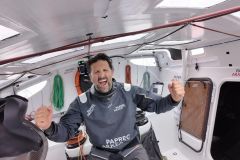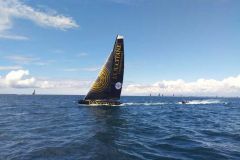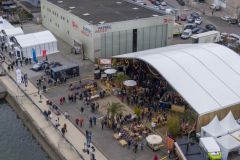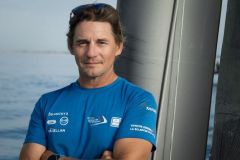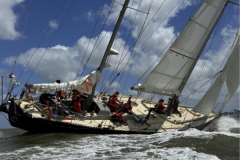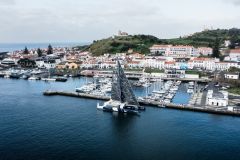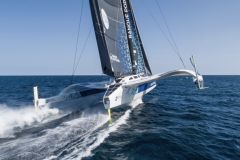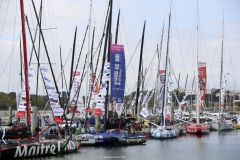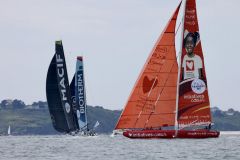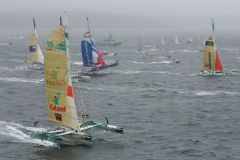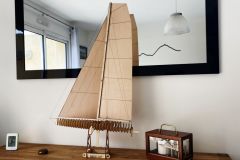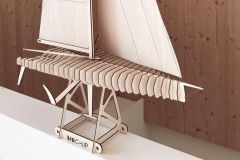Vincent Riou, skipper of PRB, currently in fifth place in the Vendée Globe, collided with a UFO on the morning of Sunday 20th November 2016, as he was making his way towards the Cape of Good Hope. Initially, he did not detect any damage and was able to continue his route without any problems. However, three hours later, the keel began to resonate and emitted constant, shrill noises, indicating an abnormal strain on the appendix. These noises continued to amplify during the night from Sunday to Monday.
With weather conditions (25 to 30 knots with average speeds of around 19-20 knots) which did not allow the keel well to be checked in the immediate future, the skipper was only able to warn his shore crew. The PRB Team as well as the boat's architect (Guillaume Verdier) and the structural calculation firm HDS GSEA Design (Hervé Devaux and Denis Glehen) then began to study all the hypotheses based on the known elements (essentially the noise emitted by the keel).
It was only on the morning of Tuesday 22nd November, with calmer conditions, that Vincent Riou was able to carry out the necessary checks. He then noticed that the keel axis - an essential titanium part of the boat - had been damaged in the impact. It enables the keel to be attached to the monohull via a plastic ball joint and it is also this axis that allows the keel to rotate.
In the impact, it is the plastic ball joint that broke, causing permanent friction between the keel pin and the ball joint support. This seriously compromises the integrity of the boat, with the risk of the keel coming loose. This is too great a risk when there is still the Indian Ocean, the Pacific Ocean and the upbound Atlantic.

Vincent Riou, who had already had to give up in 2012 after a clash with a UFO, is obviously very disappointed and sees his dream go up in smoke. From his start on 6th November last, his aim was to take the high road to the new boats equipped with foils. And that is what he has been doing ever since, being part of the leading pack from the start. For a long time neck and neck with Banque Populaire, Vincent even took second place several times and made an exceptional descent of the Atlantic with his daggerboard boat.
The skipper and PRB are currently sailing in manageable conditions (14 knots of wind) and are in contact with his shore crew to decide where he might first stop for repairs to his monohull - probably Cape Town, South Africa - before heading for France.
"Disappointment is important. But it's like every time, you have to keep on living and for me, the next step is to bring my boat back safely somewhere ashore. On the night from Sunday to Monday, I had a small bump on the bulb. The keel went off in vibration frequency. It started to move from side to side. It stopped fairly quickly. It didn't stop right away, as the boat was going at 25 knots when it happened. I didn't make more of it than that. Small bumps on the keel in offshore races, we have them regularly. This one didn't seem very strong to me.
Towards the end of the night, I began to hear crackling around the keel. Crackling that I'd heard before, as I'd had some carbon friction between the hull and the keel before. And I thought, "Well, just hold that friction a little bit, it's not too bad." But as it went along, the noise got louder and louder. I started to wonder, to think about what could have happened. I started to consult. (?). We weren't super worried, but we weren't serene either, because it's not an accessible place in the boat. Without removing the keel, you can't see exactly what happened. My approach was to say, "I'm going on. Either it's a small displacement of the keel and the carbon will wear under the bottom of the hull and the noise will gradually diminish. Or it's more serious and it's bound to damage the bearing and the noise is going to increase." I've been sailing for 24 hours. But the noise only increased until yesterday at the end of the day when I started to hear metallic noises in addition to the carbon noises. I realized that the bearing was damaged and the shaft was starting to touch the bearing cage. (?)
I've contacted the people who worked on this boat. They tried to imagine what could happen. They led me to the same decision: in the short term, it wasn't risky, because the parts are large, but quite quickly, this metal-on-metal friction could cause more serious damage. It's complicated to embark on a round-the-world trip with damage like that.
This morning, the weather calmed down after the passage of the front. I was able to open the keel well and put my hands inside. I could see that the keel was moving. At the front bearing, the hole is bigger than the keel axis. This finally confirmed my fears about damage to this bearing.
I don't know what to think. This damage occurred around the same time as the damage four years ago. When I passed Salvador a few days ago, I spent the night thinking about it. As I had passed Salvador, I said to myself, it's okay, we've driven away our demons. And in fact, just like four years ago, in the same place, 14 days after the start, we had a collision with irreparable consequences. It's hard!
The easiest way for me is to go to South Africa, Cape Town. I'm seeing if I can find everything I need there. We're getting organized with the team. I'm thinking about everyone who's been with me and following me from the beginning. I know there were a lot of people back there. I think about them very strongly. I'm disappointed for me, but I'm also disappointed for them."






